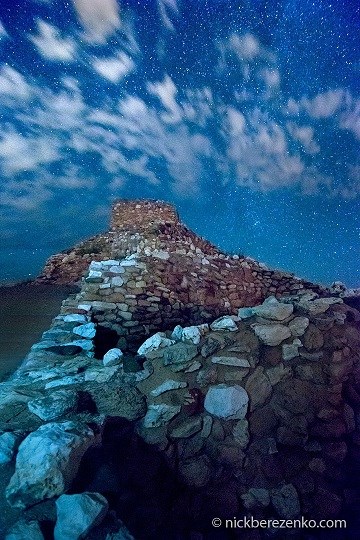
Image courtesy Nick Berezenko
Events at Tuzigoot Celebrate the Night
January 2017
The American Southwest has lured travelers, adventures, naturalist, and settlers for over 150 years. The desert offers solitude and silence. Wind, water, and time have created views that are unmatched. Arizona, arguably, holds the unofficial title for the best sunsets in the United States. Even though Phoenix is one of the fastest growing cities in the U.S., one can still drive an hour in any direction and be in total darkness looking up at a heavily salted sky of twinkling stars.
The night sky is one of Arizona’s best features. At Tuzigoot National Monument, visitors have had the opportunity to connect with this untouchable resource in some unique ways. Twice a year, the Astronomers of the Verde Valley co-host a Star Party with the park guides at Tuzigoot. Large telescopes are set up in the parking lot and each scope is trained on a unique celestial body. Some of the telescopes are so powerful that one can clearly see Saturn’s rings and Jupiter’s moons. Guest speakers are also invited to the star parties to discuss a broad range of topics, showcasing the diverse uses for and interests in the night sky.
In May of 2016, Ken Zoll, the director of the Verde Valley Archaeology Center, presented his study of the solar calendar found at a Sinagua petroglyph site which is just 30 miles from Tuzigoot Pueblo. His research shows how prehistoric Native Americans observed the shifting of the sun in the sky during the seasons. They used this shift and the casting of shadows to create a kind of sun dial which indicates planting and harvesting seasons.
Bryan Bates, and pioneer in the study of archaeo-astronomy, was kind enough to come to the Polar Bear Star Party in January of 2017. He presented the results of his research at iconic cultural sites like Wupatki and Chaco. He found that the dwellings of sun-watching cultures and features within dwellings, like windows, are aligned with the solstices and the equinoxes.
Visitors also had the opportunity to connect with the night sky artistically. In September of 2016, the Rim Country Camera Club, based out of Payson, co-hosted a night sky photography workshop. The lecture, conducted by Greg McKelvey, was open to anyone wanting to learn about proper camera settings and techniques. Then 15 registered students were escorted up to the pueblo to test their new found knowledge. The class resulted in some outstanding pieces of art and an untouchable resource captured.
Arizona is getting brighter at night because the population is growing fast, but that growth can be accomplished in a responsible way. In October of 2001, Flagstaff became the world’s first International Dark Sky City. The streetlamps and public spaces in Flagstaff are lit at a special frequency, allowing residents to still stargaze, even while standing in the middle of town. Providing unique programs like these will hopefully instill a sense of pride and protection for the disappearing resource called the Dark Sky.
Last updated: May 10, 2017
